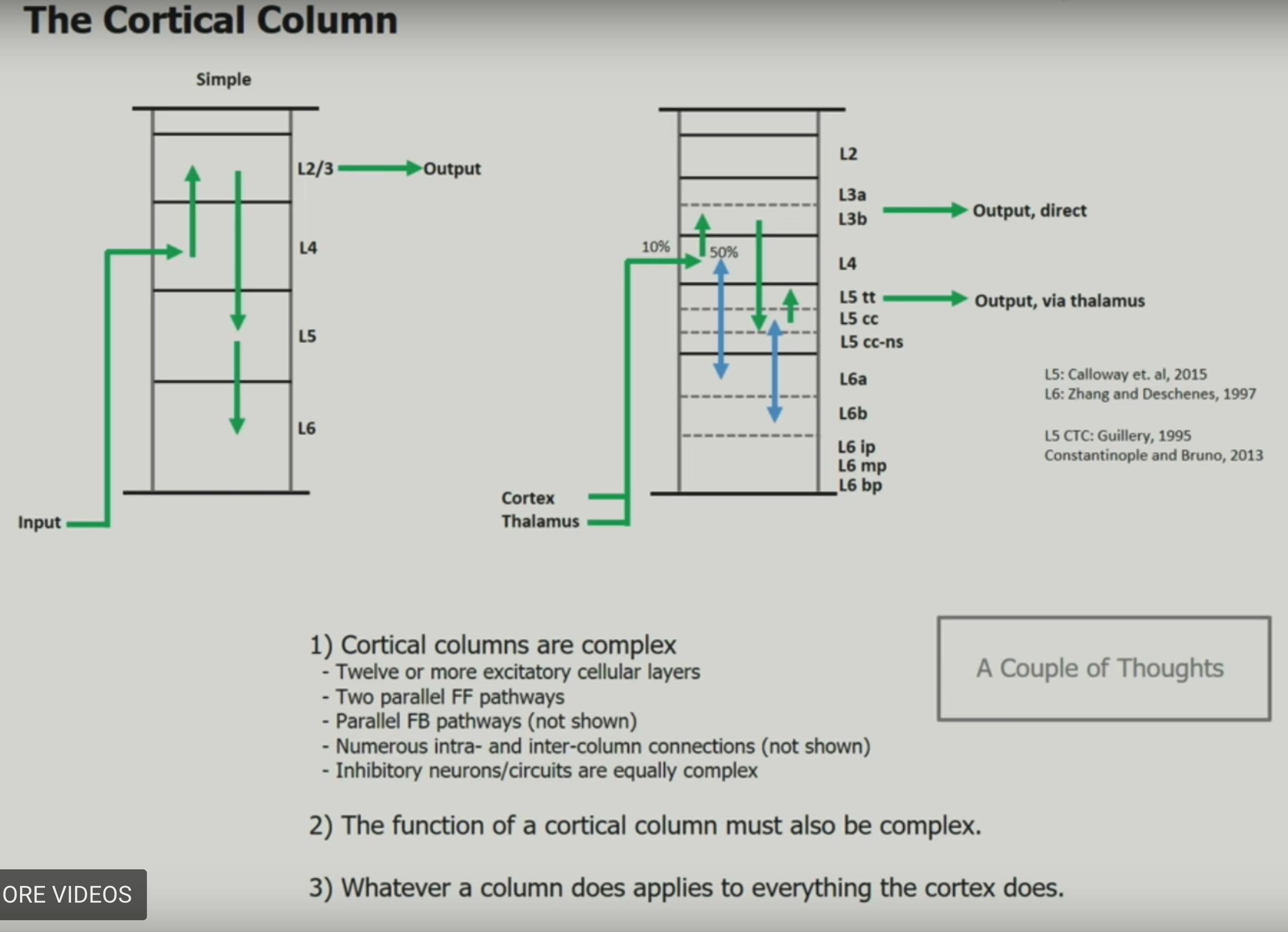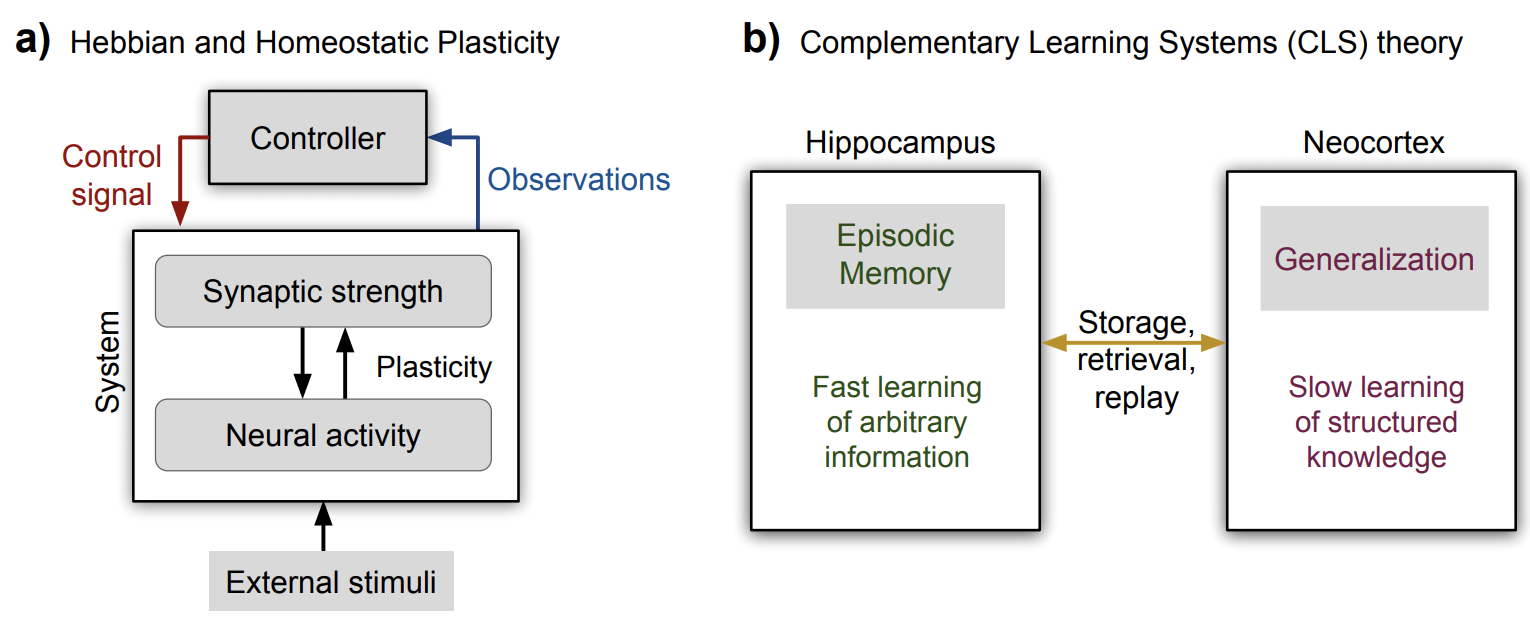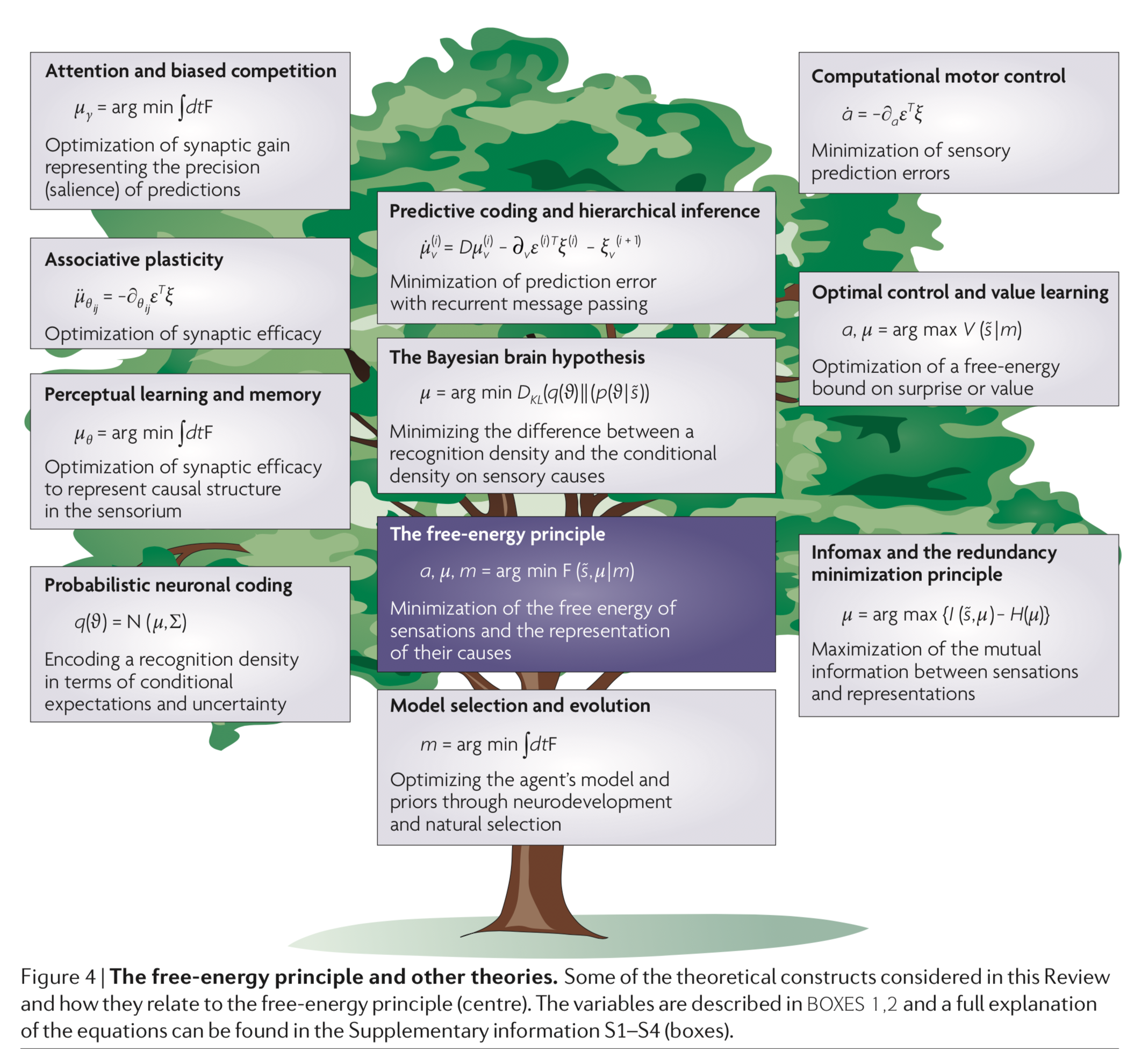comp neuro
Contents
1.1. comp neuro#
1.1.1. high-dimensional (hyperdimensional) computing#
computing with random high-dim vectors (also known as vector-symbolic architectures)
ovw talk (kanerva, 2022)
has slide with related references
A comparison of vector symbolic architectures (schlegel et al. 2021)
1.1.1.1. motivation#
high-level overview
draw inspiration from circuits not single neurons
the brain’s circuits are high-dimensional
elements are stochastic not deterministic
no 2 brains are alike yet they exhibit the same behavior
basic question of comp neuro: what kind of computing can explain behavior produced by spike trains?
recognizing ppl by how they look, sound, or behave
learning from examples
remembering things going back to childhood
communicating with language
1.1.1.2. operations#
ex. vectors \(A\), \(B\) both \(\in \{ +1, -1\}^{10,000}\) (also extends to real / complex vectors)
3 operations
addition: A + B = (0, 0, 2, 0, 2,-2, 0, ….)
alternatively, could take mean
multiplication: A * B = (-1, -1, -1, 1, 1, -1, 1, …) - this is XOR
want this to be invertible, dsitribute over addition, preserve distance, and be dissimilar to the vectors being multiplied
number of ones after multiplication is the distance between the two original vectors
can represent a dissimilar set vector by using multiplication
permutation: shuffles values (like bit-shift)
ex. rotate (bit shift with wrapping around)
multiply by rotation matrix (where each row and col contain exactly one 1)
can think of permutation as a list of numbers 1, 2, …, n in permuted order
many properties similar to multiplication
random permutation randomizes
secondary operations
weighting by a scalar
similarity = dot product (sometimes normalized)
A \(\cdot\) A = 10k
A \(\cdot\) A = 0 (orthogonal)
in high-dim spaces, almost all pairs of vectors are dissimilar A \(\cdot\) B = 0
goal: similar meanings should have large similarity
normalization
for binary vectors, just take the sign
for non-binary vectors, scalar weight
fractional binding - can bind different amounts rather than binary similar / dissimilar
1.1.1.2.1. data structures#
the operations above allow for encoding many normal data structures into a single vector
set - can be represented with a sum (since the sum is similar to all the vectors)
can find a stored set using any element
if we don’t store the sum, can probe with the sum and keep subtracting the vectors we find
multiset = bag (stores set with frequency counts) - can store things with order by adding them multiple times, but hard to actually retrieve frequencies
sequence - could have each element be an address pointing to the next element
problem - hard to represent sequences that share a subsequence (could have pointers which skip over the subsquence)
soln: index elements based on permuted sums
can look up an element based on previous element or previous string of elements
could do some kind of weighting also
pairs - could just multiply (XOR), but then get some weird things, e.g. A * A = 0
instead, permute then multiply
can use these to index (address, value) pairs and make more complex data structures
named tuples - have smth like (name: x, date: m, age: y) and store as holistic vector \(H = N*X + D * M + A * Y\)
individual attribute value can be retrieved using vector for individual key
representation substituting is a little trickier….
we blur what is a value and what is a variable
can do this for a pair or for a named tuple with new values
this doesn’t always work
1.1.1.2.2. examples#
ex. semantic word vectors
goal: get good semantic vectors for words
baseline (e.g. latent-semantic analysis LSA): make matrix of word counts, where each row is a word, and each column is a document
add counts to each column – row vector becomes semantic vector
HD computing alternative: each row is a word, but each document is assigned a few ~10 columns at random
thus, the number of columns doesn’t scale with the number of documents
can also do this randomness for the rows (so the number of rows < the number of words)
can still get semantic vector for a row/column by adding together the rows/columns which are activated by that row/column
this examples still only uses bag-of-words (but can be extended to more)
ex. semantic word vectors 2 (like word2vec)
each word in vocab is given 2 vectors
random-indexing vector - fixed random from the beginning
semantic vector - starts at 0
as we traverse sequence, for each word, add random-indexing vector from words right before/after it to its semantic vector
can also permute them before adding to preserve word order (e.g. “Permutations as a means to encode order in word space” (2008))
can instead use placeholder vector to help bring in word order (e.g. BEAGLE - Jones & Mewhort, 2007)
ex. learning rules by example
particular instance of a rule is a rule (e.g mother-son-baby \(\to\) grandmother)
as we get more examples and average them, the rule gets better
doesn’t always work (especially when things collapse to identity rule)
ex. what is the dollar of mexico? (kanerva, 2010)
initialize US = (NAME * USA) + (MONEY * DOLLAR)
initialize MEXICO = (NAME * MEXICO) + (MONEY * PESO)
query: “Dollar of Mexico”? = DOLLAR * US * MEXICO = PESO
ex. text classification (najafabadi et al. 2016)
ex. language classification - “Language Recognition using Random Indexing” (joshi et al. 2015)
scalable, easily us any-order ngrams
data
train: given million bytes of text per language (in the same alphabet)
test: new sentences for each language
training: compute a 10k profile vector for each language and for each test sentence
could encode each letter with a seed vector which is 10k
instead encode trigrams with rotate and multiply
1st letter vec rotated by 2 * 2nd letter vec rotated by 1 * 3rd letter vec
ex. THE = r(r(T)) * r(H) * r(E)
approximately orthogonal to all the letter vectors and all the other possible trigram vectors…
profile = sum of all trigram vectors (taken sliding)
ex. banana = ban + ana + nan + ana
profile is like a histogram of trigrams
testing
compare each test sentence to profiles via dot product
clusters similar languages - cool!
can query the letter most likely to follow “TH”
form query vector \(Q = r(r(T)) * r(H)\)
query by using multiply \(X = Q\) * english-profile-vec
find closest letter vecs to \(X\): yields “e”
1.1.1.3. details#
frequent “stopwords” should be ignored
mathematical background
randomly chosen vecs are dissimilar
sum vector is similar to its argument vectors
product vector and permuted vector are dissimilar to their argument vectors
multiplication distibutes over addition
permutation distributes over both additions and multiplication
multiplication and permutations are invertible
addition is approximately invertible
comparison to DNNs
both do statistical learning from data
data can be noisy
both use high-dim vecs although DNNs get bad with him dims (e.g. 100k)
new codewords are made from existing ones
HD memory is a separate func
HD algos are transparent, incremental (on-line), scalable
somewhat closer to the brain…cerebellum anatomy seems to be match HD
HD: holistic (distributed repr.) is robust
1.1.1.4. papers#
HDComputing Github Repos (see torchhd)
HD computing overview paper (Kanerva, 2009)
in these high dimensions, most points are close to equidistant from one another (L1 distance), and are approximately orthogonal (dot product is 0)
memory
heteroassociative - can return stored X based on its address A
autoassociative - can return stored X based on a noisy version of X (since it is a point attractor), maybe with some iteration
this adds robustness to the memory
this also removes the need for addresses altogether
-
note: for sparse vectors, might need some threshold before computing mean (otherwise will have too many zeros)
Neural Statistician (Edwards & Storkey, 2016) summarises a dataset by averaging over their embeddings
kanerva machine (yu…lillicrap, 2018)
like a VAE where the prior is derived from an adaptive memory store
theory of sequence indexing and working memory in RNNs
trying to make key-value pairs
VSA as a structured approach for understanding neural networks
reservoir computing = state-dependent network = echos-state network = liquid state machine - try to represen sequential temporal data - builds representations on the fly
different names
Tony plate: holographic reduced representation
ross gayler: multiply-add-permute arch
gayler & levi: vector-symbolic arch
gallant & okaywe: matrix binding with additive termps
fourier holographic reduced reprsentations (FHRR; Plate)
…many more names
1.1.2. visual sampling#
Emergence of foveal image sampling from learning to attend in visual scenes (cheung, weiss, & olshausen, 2017) - using neural attention model, learn a retinal sampling lattice
can figure out what parts of the input the model focuses on
1.1.3. dynamic routing between capsules#
hinton 1981 - reference frames require structured representations
mapping units vote for different orientations, sizes, positions based on basic units
mapping units gate the activity from other types of units - weight is dependent on if mapping is activated
top-down activations give info back to mapping units
this is a hopfield net with three-way connections (between input units, output units, mapping units)
reference frame is a key part of how we see - need to vote for transformations
olshausen, anderson, & van essen 1993 - dynamic routing circuits
ran simulations of such things (hinton said it was hard to get simulations to work)
learn things in object-based reference frames
inputs -> outputs has weight matrix gated by control
zeiler & fergus 2013 - visualizing things at intermediate layers - deconv (by dynamic routing)
save indexes of max pooling (these would be the control neurons)
when you do deconv, assign max value to these indexes
arathom 02 - map-seeking circuits
tenenbaum & freeman 2000 - bilinear models
trying to separate content + style
hinton et al 2011 - transforming autoencoders - trained neural net to learn to shift imge
sabour et al 2017 - dynamic routing between capsules
units output a vector (represents info about reference frame)
matrix transforms reference frames between units
recurrent control units settle on some transformation to identify reference frame
notes from this blog post
problems with cnns
pooling loses info
don’t account for spatial relations between image parts
can’t transfer info to new viewpoints
capsule - vector specifying the features of an object (e.g. position, size, orientation, hue texture) and its likelihood
ex. an “eye” capsule could specify the probability it exists, its position, and its size
magnitude (i.e. length) of vector represents probability it exists (e.g. there is an eye)
direction of vector represents the instantiation parameters (e.g. position, size)
hierarchy
capsules in later layers are functions of the capsules in lower layers, and since capsule has extra properties can ask questions like “are both eyes similarly sized?”
equivariance = we can ensure our net is invariant to viewpoints by checking for all similar rotations/transformations in the same amount/direction
active capsules at one level make predictions for the instantiation parameters of higher-level capsules
when multiple predictions agree, a higher-level capsule is activated
steps in a capsule (e.g. one that recognizes faces)
receives an input vector (e.g. representing eye)
apply affine transformation - encodes spatial relationships (e.g. between eye and where the face should be)
applying weighted sum by the C weights, learned by the routing algorithm
these weights are learned to group similar outputs to make higher-level capsules
vectors are squashed so their magnitudes are between 0 and 1
outputs a vector
1.1.4. hierarchical temporal memory (htm)#
binary synapses and learns by modeling the growth of new synapses and the decay of unused synapses
separate aspects of brains and neurons that are essential for intelligence from those that depend on brain implementation
1.1.4.1. necortical structure#
evolution leads to physical/logical hierarchy of brain regions
neocortex is like a flat sheet
neocortex regions are similar and do similar computation
Mountcastle 1978: vision regions are vision becase they receive visual input
number of regions / connectivity seems to be genetic
before necortex, brain regions were homogenous: spinal cord, brain stem, basal ganglia, …

1.1.4.2. principles#
common algorithims accross neocortex
hierarchy
sparse distributed representations (SDR) - vectors with thousands of bits, mostly 0s
bits of representation encode semantic properties
inputs
data from the sense
copy of the motor commands
“sensory-motor” integration - perception is stable while the eyes move
patterns are constantly changing
necortex tries to control old brain regions which control muscles
learning: region accepts stream of sensory data + motor commands
learns of changes in inputs
ouputs motor commands
only knows how its output changes its input
must learn how to control behavior via associative linking
sensory encoders - takes input and turnes it into an SDR
engineered systems can use non-human senses
behavior needs to be incorporated fully
temporal memory - is a memory of sequences
everything the neocortex does is based on memory and recall of sequences of patterns
on-line learning
prediction is compared to what actually happens and forms the basis of learning
minimize the error of predictions
1.1.4.3. papers#
“A Theory of How Columns in the Neocortex Enable Learning the Structure of the World”
network model that learns the structure of objects through movement
object recognition
over time individual columns integrate changing inputs to recognize complete objects
through existing lateral connections
within each column, neocortex is calculating a location representation
locations relative to each other = allocentric
much more motion involved
multiple columns - integrate spatial inputs - make things fast
single column - integrate touches over time - represent objects properly
“Why Neurons Have Thousands of Synapses, A Theory of Sequence Memory in Neocortex”
learning and recalling sequences of patterns
neuron with lots of synapses can learn transitions of patterns
network of these can form robust memory
1.1.5. forgetting#
Continual Lifelong Learning with Neural Networks: A Review
main issues is catastrophic forgetting / stability-plasticity dilemma

2 types of plasticity
Hebbian plasticity (Hebb 1949) for positive feedback instability
compensatory homeostatic plasticity which stabilizes neural activity
approaches: regularization, dynamic architectures (e.g. add more nodes after each task), memory replay
1.1.6. deeptune-style#
ponce_19_evolving_stimuli: https://www.cell.com/action/showPdf?pii=S0092-8674%2819%2930391-5
bashivan_18_ann_synthesis
-
use kernel regression from CNN embedding to calculate distances between preset images
select preset images
verified with macaque v4 recording
currently only study that optimizes firing rates of multiple neurons
pick next stimulus in closed-loop (“adaptive sampling” = “optimal experimental design”)
J. Benda, T. Gollisch, C. K. Machens, and A. V. Herz, “From response to stimulus: adaptive sampling in sensory physiology”
find the smallest number of stimuli needed to fit parameters of a model that predicts the recorded neuron’s activity from the stimulus
maximizing firing rates via genetic algorithms
maximizing firing rate via gradient ascent
C. DiMattina and K. Zhang,“Adaptive stimulus optimization for sensory systems neuroscience”](https://www.frontiersin.org/articles/10.3389/fncir.2013.00101/full)
2 general approaches: gradient-based approaches + genetic algorithms
can put constraints on stimulus space
stimulus adaptation
might want iso-response surfaces
maximally informative stimulus ensembles (Machens, 2002)
model-fitting: pick to maximize info-gain w/ model params
using fixed stimulus sets like white noise may be deeply problematic for efforts to identify non-linear hierarchical network models due to continuous parameter confounding (DiMattina and Zhang, 2010)
use for model selection
1.1.7. population coding#
saxena_19_pop_cunningham: “Towards the neural population doctrine”
correlated trial-to-trial variability
Ni et al. showed that the correlated variability in V4 neurons during attention and learning — processes that have inherently different timescales — robustly decreases
‘choice’ decoder built on neural activity in the first PC performs as well as one built on the full dataset, suggesting that the relationship of neural variability to behavior lies in a relatively small subspace of the state space.
decoding
more neurons only helps if neuron doesn’t lie in span of previous neurons
encoding
can train dnn goal-driven or train dnn on the neural responses directly
testing
important to be able to test population structure directly
population vector coding - ex. neurons coded for direction sum to get final direction
reduces uncertainty
correlation coding - correlations betweeen spikes carries extra info
independent-spike coding - each spike is independent of other spikes within the spike train
position coding - want to represent a position
for grid cells, very efficient
sparse coding
hard when noise between neurons is correlated
measures of information
eda
plot neuron responses
calc neuron covariances
1.1.8. interesting misc papers#
berardino 17 eigendistortions
Fisher info matrix under certain assumptions = \(Jacob^TJacob\) (pixels x pixels) where Jacob is the Jacobian matrix for the function f action on the pixels x
most and least noticeable distortion directions corresponding to the eigenvectors of the Fisher info matrix
gao_19_v1_repr
don’t learn from images - v1 repr should come from motion like it does in the real world
repr
vector of local content
matrix of local displacement
why is this repr nice?
separate reps of static image content and change due to motion
disentangled rotations
learning
predict next image given current image + displacement field
predict next image vector given current frame vectors + displacement
kietzmann_18_dnn_in_neuro_rvw
friston_10_free_energy


